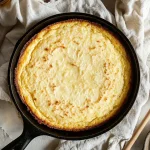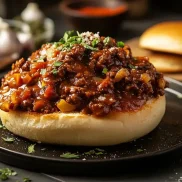Cornbread is a beloved staple in Southern kitchens, symbolizing history and tradition. But one question often arises: Why do southerners not put sugar in cornbread? This simple query reveals the cultural and historical roots of Southern cuisine. While many regions enjoy sweetened versions, Southern cornbread remains a savory classic, prized for its authenticity and simplicity. Learn more in this detailed Southern cornbread recipe guide.
To understand this preference, we must explore Southern culture. Cornbread is more than food; it tells a story of resilience and tradition. Each bite reflects a region shaped by its history, ingredients, and values. This article examines the origins of this dish, from Native American influences to its colonial evolution and lasting legacy.
Table of Contents
Why Do Southerners Not Put Sugar in Cornbread? A Look at Its History
Origins of Cornbread in Southern Cuisine
Cornbread’s roots trace back to the earliest inhabitants of what we now call the American South. Native Americans, the original stewards of the land, cultivated corn as a dietary staple. They ground it into meal and used it to create flatbreads and griddle cakes, which would later inspire the cornbread we recognize today. Their culinary practices reflected a deep connection to the land, utilizing locally available resources to sustain their communities.
When European settlers arrived, they adopted these practices, finding corn to be a versatile and hardy crop. Unlike wheat, which struggled to thrive in the Southern climate, corn flourished. Its abundance made it a cornerstone of the settlers’ diet, ensuring sustenance during both lean and prosperous times. Over time, cornbread became more than a practical food item; it evolved into a symbol of survival and ingenuity.
Influence of Native American Recipes
The influence of Native American recipes on Southern cornbread cannot be overstated. Early settlers borrowed techniques such as grinding corn into meal and cooking it over open flames or in hot ashes. Native Americans used minimal ingredients—often just cornmeal, water, and salt—to create dishes that were nutritious and filling.
This simplicity carried over into Southern cooking traditions. For centuries, the focus remained on preserving the pure, earthy flavor of corn without overshadowing it with sweeteners or elaborate seasonings. The savory nature of cornbread was not only practical but also a reflection of the Native American philosophy of honoring natural flavors.
Evolution Through the Colonial Era
As Southern cuisine evolved through the colonial era, so did its cornbread recipes. The introduction of cast-iron cookware revolutionized the way cornbread was prepared, giving rise to the beloved skillet cornbread with its signature golden crust. Settlers experimented with variations, adding buttermilk, lard, or eggs to enhance texture and flavor, but the fundamental savory profile remained unchanged.
Unlike their Northern counterparts, who had access to a wider variety of sweeteners like molasses and honey, Southern cooks often reserved sugar for desserts or other special dishes. Cornbread’s role as an accompaniment to hearty meals like beans, greens, and stews further solidified its savory identity. Sweet cornbread, in contrast, was seen as a deviation from tradition, more suited to different regions and tastes.
Today, Southern cornbread continues to be celebrated for its rustic charm and historical significance. Each recipe tells a story, connecting modern-day cooks to generations past. Understanding its journey from Native American innovation to a cornerstone of Southern cuisine highlights why this dish remains a savory treasure, resisting the addition of sugar even as culinary trends evolve.
Understanding Traditional Southern Ingredients
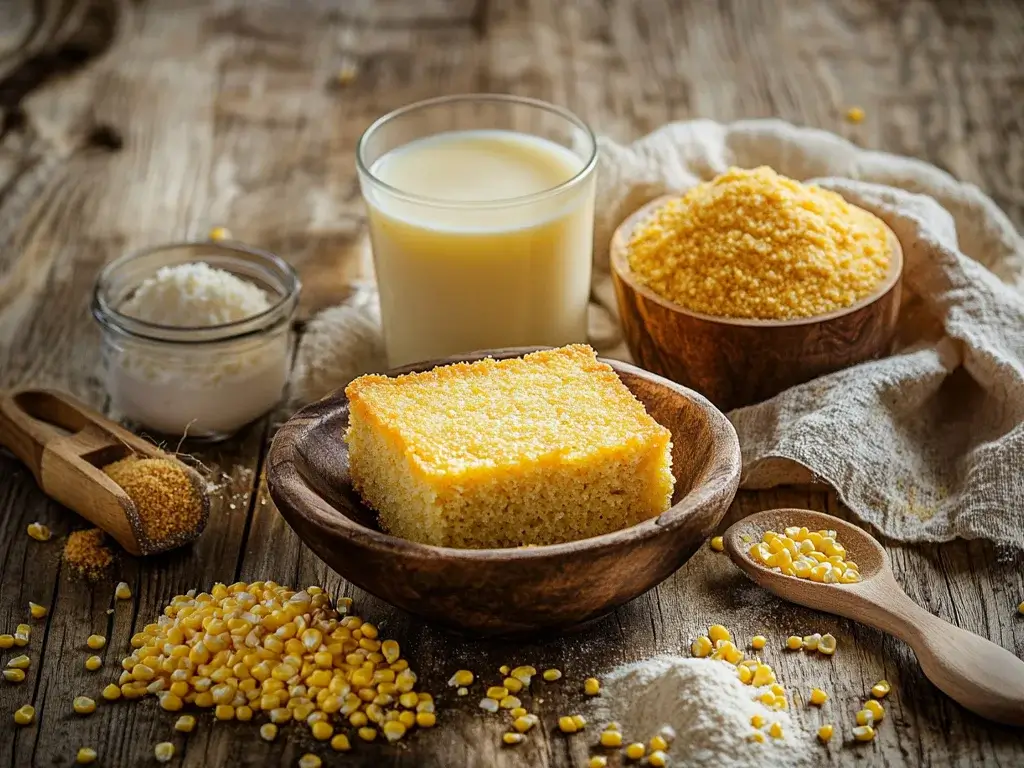
Cornmeal vs. Sweeteners: The Core Ingredients
At the heart of Southern cornbread lies a deliberate choice of ingredients, reflecting the region’s culinary identity. Cornmeal, a coarsely ground flour made from dried corn, serves as the cornerstone of this iconic dish. Unlike all-purpose flour, cornmeal’s texture and flavor bring a rustic quality to cornbread, celebrating the earthy essence of its main ingredient.
One key distinction in Southern cornbread is the absence of sweeteners like sugar, molasses, or honey. This omission isn’t accidental but rooted in tradition and practicality. Historically, sugar was considered a luxury item in many Southern households, reserved for desserts and special occasions. Cornbread, on the other hand, was a daily staple—a practical, savory side that complemented hearty meals without overshadowing them.
The debate between sweet and savory cornbread often highlights cultural differences. Northern cornbread, enriched with sugar, tends to resemble a cake-like bread, appealing to those who favor sweetness in their meals. In contrast, Southern cornbread prides itself on authenticity and functionality, using minimal ingredients to create a dish that is both versatile and satisfying. By focusing on cornmeal’s natural flavor, Southern cooks honor the ingredient’s integrity, allowing it to shine without interference.
Regional Availability of Ingredients in the South
The South’s agricultural landscape played a pivotal role in shaping its cornbread recipes. Corn, a resilient crop that thrived in the region’s warm climate, became a dietary cornerstone for both Native Americans and European settlers. Its abundance made it an accessible and affordable ingredient, ensuring its widespread use in everyday cooking.
In contrast, sweeteners like sugar and molasses were less readily available in rural Southern areas, particularly during the 19th and early 20th centuries. These ingredients were either imported at a premium or produced in limited quantities, making them impractical for daily use. This scarcity influenced Southern cooks to develop recipes that relied on readily available resources, such as cornmeal, buttermilk, and lard, rather than imported or costly ingredients.
Even as modern supply chains have made sugar more accessible, the tradition of unsweetened cornbread persists. For many Southerners, this choice is about more than practicality; it’s a nod to their ancestors’ resourcefulness and respect for the land’s bounty.
Emphasis on Simplicity in Southern Cooking
Simplicity is a hallmark of Southern cooking, and cornbread is no exception. The traditional recipe often consists of just a handful of ingredients: cornmeal, water or buttermilk, salt, and a leavening agent like baking soda. This minimalist approach not only highlights the natural flavors of the ingredients but also reflects the region’s culinary philosophy.
Southern cooking values authenticity and practicality over complexity. The goal is to create dishes that are nourishing, flavorful, and accessible to all, regardless of one’s economic standing. Cornbread exemplifies this ethos, requiring no elaborate preparation or exotic ingredients. Its simplicity ensures that it pairs seamlessly with a variety of dishes, from collard greens and black-eyed peas to fried chicken and barbecue.
Moreover, the unsweetened nature of Southern cornbread underscores its role as a supporting player in meals. Unlike sweetened bread, which can dominate the palate, savory cornbread enhances the flavors of accompanying dishes without competing with them. This balance makes it a versatile and enduring staple in Southern cuisine, treasured for its ability to bring meals together harmoniously.
By embracing cornmeal’s natural qualities and emphasizing simplicity, Southern cooks have preserved the integrity of their cornbread recipes for generations. This commitment to tradition is a testament to the region’s respect for its culinary roots and its dedication to honoring the past while feeding the present.
Culinary Philosophy of Southern Cooking
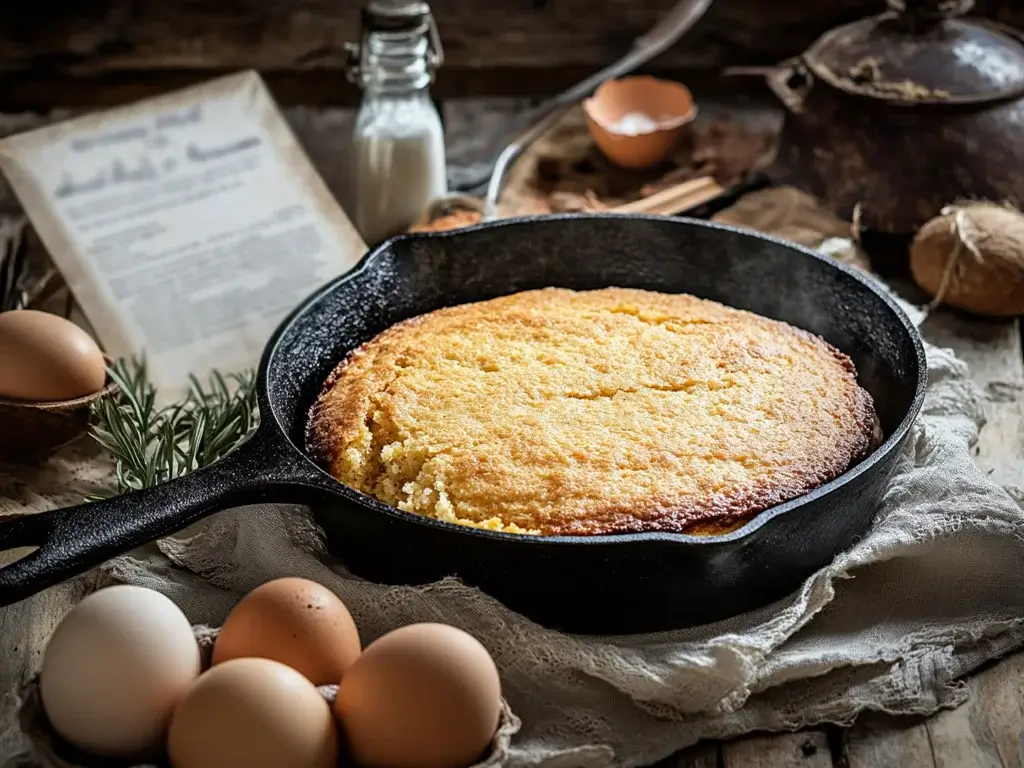
Respect for Authentic Flavors
Southern cooking is steeped in a deep respect for authentic flavors, and this philosophy is evident in every dish, especially cornbread. Unlike recipes that rely on elaborate seasonings or sweeteners, Southern cooks aim to celebrate the natural essence of their ingredients. Cornbread, made with the simplest components, serves as a perfect example of this commitment.
The Southern culinary ethos values the taste of fresh, locally sourced ingredients. Cornmeal, the star ingredient in traditional cornbread, offers a nutty, earthy flavor that shines when left unadulterated. By resisting the temptation to add sugar or overpowering spices, Southern cooks let the true character of the cornmeal take center stage. This approach not only honors the ingredient but also preserves the historical authenticity of the dish.
This respect for authentic flavors reflects a broader cultural attitude in the South. Meals are seen as a way to connect with the land, the seasons, and one another. Dishes like cornbread, with their straightforward preparation and focus on natural taste, reinforce this connection, reminding diners of the value of simplicity and quality over excess. By sticking to tradition, Southern cooks pass down more than recipes—they preserve a way of life that values honesty and integrity in every bite.
Avoiding Unnecessary Additions
In Southern cooking, less is more. Avoiding unnecessary additions is key to the region’s culinary philosophy. For cornbread, this means excluding ingredients that distract from its role as a savory, versatile side.
Sugar is often seen as unnecessary and changes cornbread from a humble staple to something unintended. Traditional cornbread complements hearty dishes like greens, beans, and stews without overshadowing them. Southern cooks value recipes that enhance rather than dominate a meal.
This simplicity is practical and rooted in tradition. Historically, luxury ingredients like sugar were scarce, leading to resourceful recipes that remain popular today. Many modern Southern cooks continue to prioritize these straightforward, authentic methods.
By focusing on intention and simplicity, Southern cooking avoids unnecessary complexity. Cornbread, in its unsweetened form, reflects this timeless philosophy and its honest, straightforward flavors.
Regional Variations in Cornbread Recipes
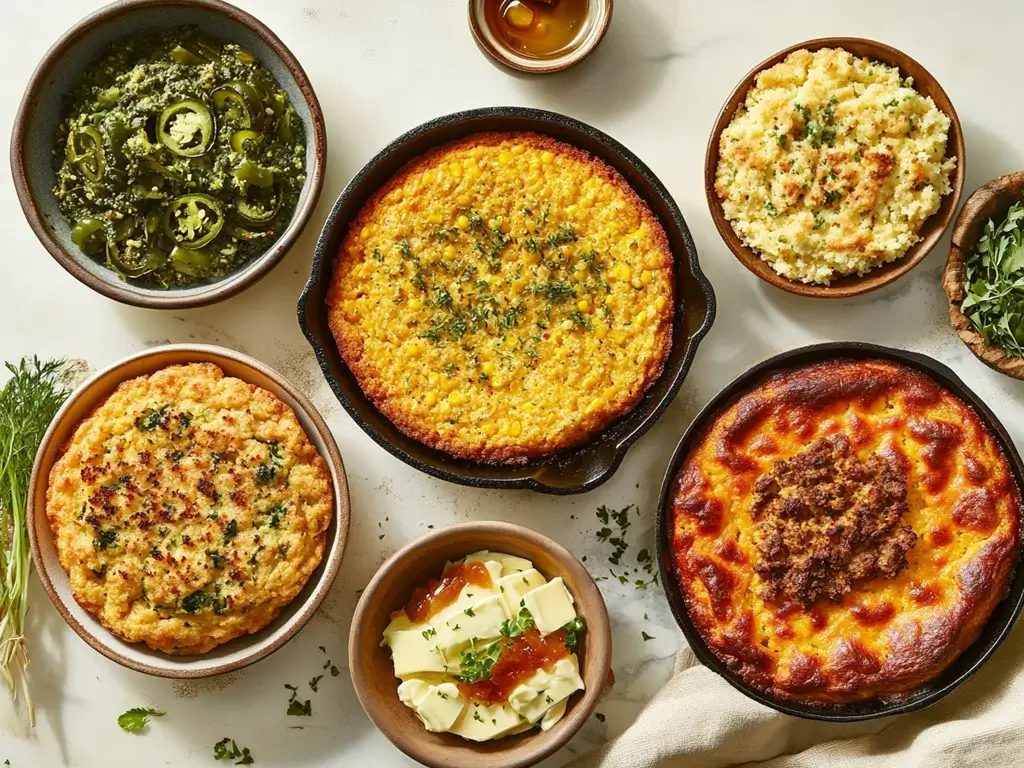
Northern Cornbread: A Sweet Contrast
When comparing cornbread across regions, the Northern version stands out for its sweet, cake-like qualities. Northern cornbread recipes typically incorporate sugar, honey, or molasses, resulting in a bread that’s moist and rich. This sweetness aligns with the preferences of many Northern cooks, who often serve cornbread as a standalone item or pair it with lighter fare such as soups or salads.
The texture of Northern cornbread also differs significantly from its Southern counterpart. All-purpose flour is often used alongside cornmeal, creating a softer, more delicate crumb. Additional ingredients like butter and milk further enhance its richness, making it feel more indulgent. While these characteristics make Northern cornbread a favorite for many, they’re a far cry from the rustic, savory traditions cherished in the South.
This divergence in style reflects broader cultural and historical differences. The North’s access to a variety of sweeteners and a tendency toward more elaborate baking practices influenced the evolution of their cornbread recipes. Though sweet cornbread enjoys popularity in the North, it’s often viewed as a departure from the traditional roots of the dish.
Southern Cornbread: A Savory Tradition
In the South, cornbread is more than a dish; it’s a culinary cornerstone. Southern cornbread is savory, made without sugar, emphasizing the earthy flavor of cornmeal. This reflects the region’s history of practicality and resourcefulness.
Traditional recipes often use coarse cornmeal, buttermilk, and lard or bacon drippings for richness. The result is a crumbly texture with a golden crust, typically baked in a cast-iron skillet. This method enhances flavor and honors time-tested cooking techniques.
Savory cornbread pairs perfectly with hearty dishes like collard greens, black-eyed peas, and barbecue. It complements rather than competes, which is why sugar is absent from most traditional Southern recipes.
Border States and Hybrid Recipes
The culinary traditions of border states often blur the lines between Northern and Southern cornbread styles, creating unique hybrid recipes. In states like Kentucky, Tennessee, and Missouri, cooks might incorporate a touch of sugar while still emphasizing the savory qualities of Southern cornbread. These hybrid versions serve as a bridge between two distinct traditions, offering the best of both worlds.
Hybrid cornbread recipes might include a combination of all-purpose flour and cornmeal, resulting in a texture that balances the density of Southern cornbread with the softness of Northern varieties. Sweeteners are used sparingly, often just enough to enhance the natural sweetness of the cornmeal without overwhelming its flavor. Other regional adaptations might include the addition of jalapeños, cheese, or herbs, reflecting local tastes and ingredients.
These variations highlight the adaptability of cornbread as a dish. While traditional Southern cornbread remains a benchmark for authenticity, the diversity of recipes found in border states demonstrates how cornbread continues to evolve, reflecting the blending of cultures and culinary influences. For many, these hybrid recipes offer a way to honor tradition while embracing innovation, creating a dish that feels both familiar and new.
The Role of Cornbread in Southern Culture
A Staple of Comfort Food
Cornbread has long been a staple of comfort food in Southern cuisine, embodying warmth, simplicity, and a sense of home. Its rustic flavor and crumbly texture make it the perfect accompaniment to a variety of hearty dishes, from collard greens and stews to fried chicken and barbecue. For many Southerners, a meal feels incomplete without a slice of freshly baked cornbread on the side.
The comforting nature of cornbread stems from its deep cultural and historical roots. During times of hardship, cornbread was a reliable and affordable source of sustenance. Its straightforward preparation and readily available ingredients meant that families could easily incorporate it into their daily meals. Over generations, this association with nourishment and resilience transformed cornbread into more than just a food item; it became a symbol of home and togetherness.
Today, the enduring appeal of cornbread as a comfort food lies in its versatility. It can be served warm from the oven, crumbled into soups, or even used as a base for stuffing. Its ability to adapt to various culinary contexts while retaining its traditional essence ensures its continued place in Southern kitchens.
Cornbread in Southern Gatherings and Celebrations
In the South, food is often central to gatherings and celebrations, and cornbread holds a prominent place at these events. Whether it’s a family reunion, a church potluck, or a holiday feast, cornbread is a dish that brings people together. Its presence on the table signifies hospitality, tradition, and a shared appreciation for Southern culinary heritage.
At larger gatherings, cornbread frequently appears in multiple forms. You might find a classic skillet cornbread alongside cornbread muffins or a spicy jalapeño version. Its versatility allows hosts to cater to a variety of tastes while staying true to its roots. Cornbread dressing, a beloved Thanksgiving staple in the South, is another way this dish shines during celebratory meals.
The communal act of making cornbread also plays a role in its cultural significance. In many families, preparing cornbread together is a cherished tradition, with recipes passed down from one generation to the next. This shared experience reinforces bonds and keeps the memory of loved ones alive, making cornbread a dish that’s as much about connection as it is about flavor.
Legacy and Passing Down of Recipes
The legacy of cornbread in Southern culture is tightly linked to passing down recipes through generations. For many families, these recipes are more than instructions—they are connections to the past, often including unique touches like a secret ingredient or special technique.
Teaching younger generations to make cornbread is a cherished tradition. It’s about more than learning a recipe; it’s about embracing the values and stories the dish represents. This keeps the cultural significance of cornbread alive, even as modern influences evolve Southern cuisine.
Today, cornbread’s history is shared widely through cookbooks and social media, but its heart remains in family kitchens. Cornbread continues to unite people, preserve history, and nourish both body and soul.
Frequently Asked Questions
What is the difference between cornbread and Southern cornbread?
The primary difference lies in the sweetness and texture. Traditional Southern cornbread is savory, made without sugar, and uses coarser cornmeal for a crumbly texture. It’s often baked in a cast-iron skillet to achieve a golden crust. In contrast, other cornbread varieties, like those from the North, tend to include sugar or sweeteners and use finer cornmeal, resulting in a sweeter and softer bread. The savory nature of Southern cornbread complements hearty dishes, making it a versatile side dish in Southern cuisine. Learn more
Is it better to use buttermilk or milk in cornbread?
Southern cornbread recipes often use buttermilk because it adds tangy flavor and creates a tender texture. Its acidity reacts with baking soda or baking powder to help the bread rise and become fluffy. Regular milk can substitute but lacks the richness and tang, making the cornbread less flavorful and moist. Learn more
What ingredient keeps cornbread from crumbling?
To keep cornbread from crumbling, use fats and binding ingredients. Eggs add structure and hold the bread together, while butter, oil, or bacon drippings provide moisture and richness. Buttermilk, instead of regular milk, improves consistency because its acidity helps bind the ingredients. Maintaining the right ratio of cornmeal to liquids is also vital for a cohesive texture. Learn more
Why do Southerners prefer unsweetened cornbread?
Southerners prefer unsweetened cornbread because it aligns with traditional cooking practices that prioritize the natural flavor of cornmeal. Historically, sugar was a luxury item, so cornbread was made with minimal ingredients that were readily available. The savory profile pairs well with hearty Southern dishes like beans, greens, and stews, enhancing their flavors rather than overpowering them.
Can you make Southern cornbread gluten-free?
Yes, Southern cornbread can be made gluten-free by using 100% cornmeal or a gluten-free cornmeal blend. Many traditional recipes already omit wheat flour, but it’s essential to check the cornmeal packaging for cross-contamination warnings if you have gluten sensitivities. You can also use gluten-free baking powder or baking soda to ensure the bread rises properly.
What’s the best way to achieve a crispy crust on cornbread?
The secret to a crispy crust lies in the use of a preheated cast-iron skillet. Before pouring the batter, heat the skillet in the oven with a generous coating of oil, butter, or bacon drippings. The hot surface sears the batter immediately upon contact, forming a golden, crispy crust as it bakes. This technique is a hallmark of traditional Southern cornbread preparation.
Conclusion
Cornbread is more than a side dish; it’s a symbol of Southern culture. The question, “Why do Southerners not put sugar in cornbread?”, tells a story of resourcefulness and respect for tradition. By focusing on simple, natural ingredients, Southern cooks honor the true character of cornmeal.
Served with stews, crumbled into soups, or eaten alone, Southern cornbread reflects the region’s culinary roots. Its unsweetened profile keeps it versatile, pairing well with hearty meals while preserving its rustic charm.
Despite changing trends, Southern cornbread’s appeal endures. Its legacy shows the value of tradition and adaptation, ensuring it remains a beloved dish for generations.

